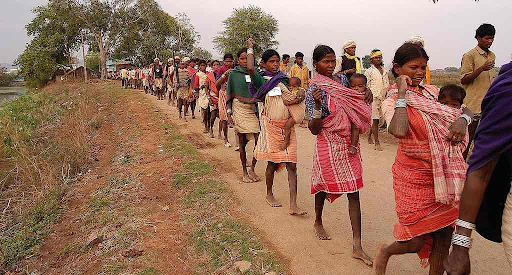Description

Disclaimer: Copyright infringement not intended.
Context
- The Bhojshala-Kamal Maula complex in Madhya Pradesh's Dhar district has been a subject of dispute, requiring a scientific survey to uncover its historical origins and clarify its current structure.
Bhojshala: A Historical Monument in Dhar, Madhya Pradesh
Location and Name Origin
- Situated in Dhar, Madhya Pradesh, Bhojshala derives its name from King Bhoja of the Paramāra dynasty, renowned for his support of education and the arts.
Historical Context
- The architectural features of Bhojshala predominantly date back to the 12th century, with additional Islamic tombs added during the 14th and 15th centuries.
- It holds the status of a Monument of National Importance under the protection of the Archaeological Survey of India (ASI).
Architecture:
- The monument in Dhar showcases distinctive architectural style with sandstone pillars from 11th and 12th centuries.
- Pillar Stacking Technique: Pillars stacked to increase ceiling height, similar to practices at Ajmer and Qutb complex, Delhi.
- Decorative Elements: Trabeate domes adorned with cusping and lotus motifs added over time.
- Additions in 1400s: Mihrab and minbar added during the Malwa Sultanate's reign in the 1400s.
- Inscriptions: Stone panels with Sanskrit and Prakrit inscriptions, displaying grammatical rules and esoteric diagrams.
- Historical Significance: Recent discoveries suggest a ritual fire place (yajña kuṇḍ) in the courtyard, highlighting diverse historical layers.

Dispute
- The ASI-protected 11th-century monument, Bhojshala, is regarded by Hindus as a temple dedicated to Vagdevi (Goddess Saraswati), whereas the Muslim community refers to it as Kamal Maula Mosque.
Current Status and Usage
- Bhojshala serves as a site for prayers by both Hindus and Muslims, with designated days allocated for each community.
- It is a disputed location and notionally claimed by both Muslims and Hindus, although the Republic of India has ultimate authority and jurisdiction over it.
- The ASI permits worship by Hindus on Tuesday and Muslims on Friday for two hours each week.
- Its administration is governed by the Places of Worship (Special Provisions) Act, 1991, and the Ancient Monuments and Archaeological Sites and Remains Rules, 1959.
Terminology
- The term "Bhojśālā" was officially associated with the structure in the early 20th century, following inscriptions discovered by K. K. Lele.
Legacy of King Bhoja
- King Bhoja is celebrated for his significant contributions to arts and education, with numerous Sanskrit literary works attributed to his patronage.
Exploration and Inscriptions
- Early scholars and administrators during the colonial era studied inscriptions at Bhojshala, including verses venerating Viṣṇu's Tortoise incarnation and dramatic scripts.
Social Tensions and Legal Challenges
- Occasional tensions arise when Hindu and Muslim prayer days coincide, occasionally leading to disturbances.
- Legal disputes over the site's status have periodically emerged, including a recent challenge in 2024.
Conclusion
- Bhojshala stands as a testament to India's rich cultural and historical heritage, exemplifying architectural splendor and the complexities of religious coexistence.
- Its significance transcends time, reflecting the profound cultural contributions of King Bhoja and the enduring legacy of ancient Indian civilization.
|
Paramara Dynasty
The Paramara dynasty was a prominent medieval Indian ruling family that governed central India from the 9th to the 14th centuries. They are renowned for their control over the Malwa region, establishing their capitals initially at Ujjain and later at Dhar and Mandu. King Upendra or Krishnaraja is traditionally regarded as the founder of the Paramara dynasty. Known for their profound patronage of art, literature, and culture, the Paramaras produced a significant cultural and architectural heritage. King Bhoja, among their most illustrious rulers, is celebrated for his support of learning and the arts. The dynasty's legacy includes the construction of renowned temples and monuments, such as those at Khajuraho, contributing notably to regional art, architecture, and Sanskrit literature in India. Historian D.C. Ganguly theorizes a potential ancestral connection between the Paramara and Rashtrakuta dynasties, as suggested by the Harsola copper plates (949 CE). Inscriptions from the 10th century, attributed to ruler Siyaka, are among the earliest surviving Paramara records, discovered in Gujarat. The dynasty reached its zenith under Bhoja, whose realm extended from Chittor in the north to Konkan in the south, and from the Sabarmati River in the west to Vidisha in the east.
|
|
PRACTICE QUESTION
Q. Consider the following statements regarding the Bhojshala Complex:
- The Bhojshala-Kamal Maula Complex is located in the state of Madhya Pradesh.
- It is an archaeological site that houses a mosque and a temple, reflecting the intermingling of Hindu and Islamic architectural styles.
- The complex was named after King Bhoja, a renowned ruler of the Paramara dynasty.
Which of the statements given above is/are correct?
- 1 and 2 only
- 2 and 3 only
- 1 and 3 only
- 1, 2, and 3
Answer:
D. 1, 2, and 3
|
SOURCE: THE HINDU















